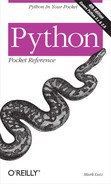This section lists common Python coding tricks and general usage hints. Consult the Python Library Reference and Python Language Reference (http://www.python.org/doc/) for further information on topics mentioned here.
S[:]makes a top-level (shallow) copy of any sequence;copy.deepcopy(X)makes full copies;list(L)andD.copy()copy lists and dictionaries.L[:0]=[X,Y,Z]inserts items at front of listL, in-place.L[len(L):]=[X,Y,Z],L.extend([X,Y,Z]), andL+=[X,Y,Z]all insert multiple items at the end of a list, in-place.L.append(X)andX=L.pop()can be used to implement in-place stack operations, where the end of the list is the top of the stack.Use
for key in D.keys():to iterate through dictionaries, or simplyfor key in D:in version 2.2 and later. In Python 3.0 these two forms are equivalent, sincekeysis an iterable view.Use
for key in sorted(D):to iterate over dictionary keys in sorted fashion in version 2.4 and later; the formK=D.keys(); K.sort(); for key in K:also works in Python 2.X but not Python 3.0, sincekeysresults are view objects, not lists.X=A or B or NoneassignsXto the first true object amongAandB, orNoneif both are false (i.e., 0 or empty).X,Y = Y,Xswaps the values ofXandY.red, green, blue = range(3)assigns integer series.Use
try/finallystatements to ensure that arbitrary termination code is run; especially useful around locking calls (acquire before thetry, release in thefinally).Use
with/asstatements to guarantee that object-specific termination code is run; for objects that support the context manager protocol (e.g., file auto-close, tread lock auto-release).Wrap iterables in a
list()call to view all their results interactively in Python 3; this includesrange(),map(),zip(),filter(),dict.keys(), and more.
Use
if __name__ == '__main__':to add self-test code or a call to a main function at the bottom of module files; true only when file is run, not when it is imported as a library component.To load file contents in a single expression, use
data=open('filename').read().To iterate through text files by lines, use
for line in file:in version 2.2 and later (in older versions, usefor line in file.readlines():).To retrieve command-line arguments, use
sys.argv.To retrieve shell environment settings, use
os.environ.The standard streams are:
sys.stdin,sys.stdout, andsys.stderror.To return a list of files matching a given pattern, use:
glob.glob('pattern').To return a list of files and subdirectories on a path, use:
os.listdir('.').To walk an entire tree of directories, use
os.walkin Python 3.0 and 2.6 (os.path.walkis also available in Python 2.6 only).To run shell commands within Python scripts, you can use
os.system('cmdline'),output=os.popen('cmdline', 'r').read(). The latter form reads the spawned program’s standard output, and may also be used to read line-by-line.Other streams of a spawned command are available via the
subprocessmodule in Python 3.0, and theos.popen2/3/4calls in Python 2.X only. Theos.fork/os.exec*calls have similar effect on Unix-like platforms.To make a file an executable script on Unix-like platforms, add a line like
#!/usr/bin/env pythonor#!/usr/local/bin/pythonat the top and give the file executable permissions with achmodcommand. On Windows, files can be clicked and run directly due to the registry.The
dir([object])function is useful for inspecting attribute namespaces;print(object.__doc__)often gives documentation.The
help([object])function provides interactive help for modules, functions, types, and more;help(str)gives help on thestrtype;help("module")gives help on modules even if they have not yet been imported; andhelp("topic")gives help on keywords and other help topics (use"topics"for a list of help topics).print()andinput()(known asprintandraw_input()in Python 2.X) usesys.stdoutandsys.stdinstreams: assign to file-like objects to redirect I/O internally, or use theprint(..., file=F)form in Python 3.0 (or theprint >> F, ...form in Python 2.X).
Use
from __future__ importfeaturenameto enable experimental language features that might break existing code.Intuition about performance in Python programs is usually wrong: always measure before optimizing or migrating to C. Use the
profileandtimemodules (as well as cProfile and timeit).See modules
unittest(a.k.a. PyUnit) anddoctestfor automated testing tools shipped with the Python standard library;unittestis a class framework;doctestscans documentation strings for tests and outputs.See the
pydoclibrary module and script shipped with Python for extraction and display of documentation strings associated with modules, functions, classes, and methods.See the section Warnings Framework, as well as
-Win the section Command-Line Options, for details about turning off future-deprecation warnings emitted by the interpreter.See Distutils, PyInstaller, py2exe, eggs, and other tools for Python program distribution options.
See PyInstaller and py2exe for turning Python programs into .exe files for Windows.
See NumPy, SciPy, and related packages for extensions that turn Python into a numeric-scientific-programming tool with vector objects, etc.
See ZODB and others for full-featured OODB support that allows Python native objects to be stored by key, and SQLObject, SQLAlchemy, and others for object relational mappers that allow classes to be used with relational tables.
See SWIG (among others) for a tool that can automatically generate glue code for using C and C++ libraries within Python scripts.
See IDLE for a development GUI shipped with Python, with syntax-coloring text editors, object browsers, debugging, etc.; see also PythonWin, Komodo, Eclipse, NetBeans, and others for additional IDE options.
See Emacs help for tips on editing/running code in the Emacs text editor. Most other editors support Python as well (e.g., auto-indenting, coloring), including VIM and IDLE; see the editors’ page at www.python.org.
Porting to Python 3.0: use the
−3command-line option in Python 2.6 to issue incompatibility warnings, and see the 2to3 script which automatically converts much 2.X code to run under 3.X Python.
Important websites to refer to:
- http://www.python.org
The Python home page
- http://oreilly.com
The publisher’s home page
- http://www.python.org/pypi
Additional third-party Python tools
- http://www.rmi.net/~lutz
The author’s site
Python philosophy:
import this.You should say
spamandeggsinstead offooandbarin Python examples.
